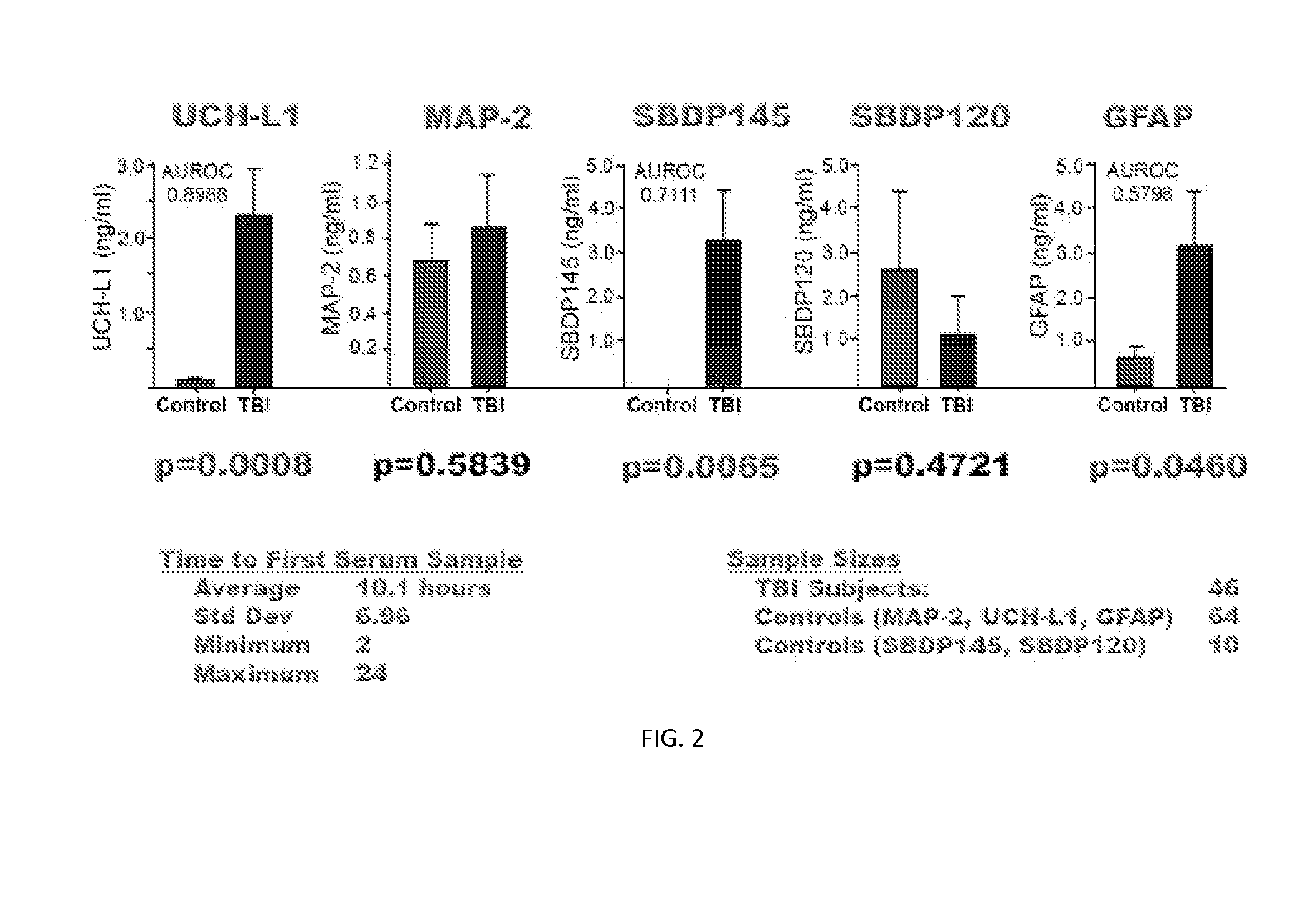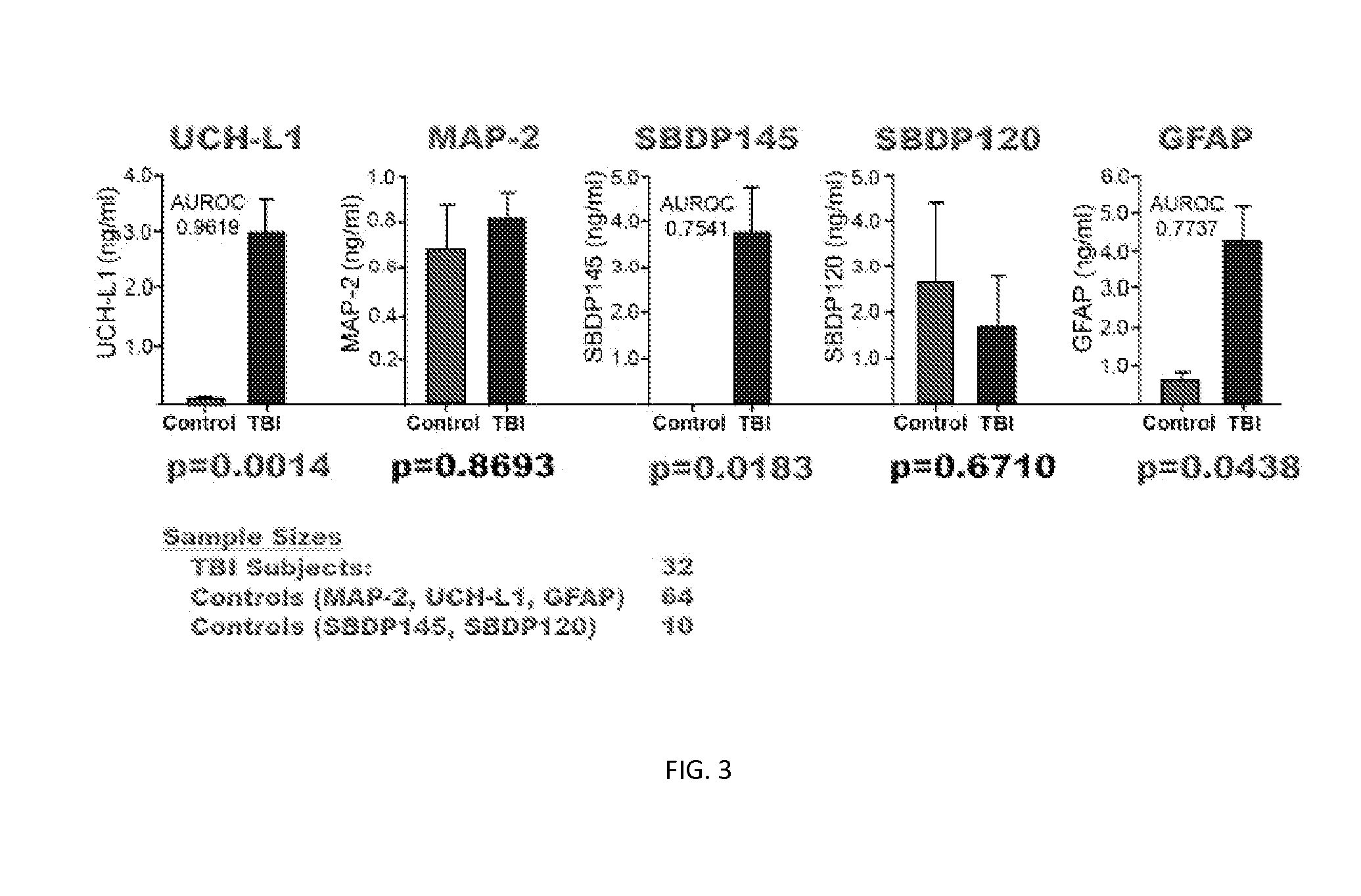Biomarker assay of neurological condition
a biomarker and neurological technology, applied in the field of neurological condition determination, can solve the problems of brain damage prospect, cost and time-consuming spectroscopic imaging, and diagnostic limitations, and achieve the effect of increasing the level of gfap
- Summary
- Abstract
- Description
- Claims
- Application Information
AI Technical Summary
Benefits of technology
Problems solved by technology
Method used
Image
Examples
example 1
[0116]Materials for Biomarker Analyses. Sodium bicarbonate, (Sigma Cat #: C-3041), blocking buffer (Startingblock T20-TBS) (Pierce Cat#: 37543), Tris buffered saline with Tween 20 (TBST; Sigma Cat #: T-9039). Phosphate buffered saline (PBS; Sigma Cat #: P-3813); Tween 20 (Sigma Cat #: P5927); Ultra TMB ELISA (Pierce Cat #: 34028); and Nunc maxisorp ELISA plates (Fisher). Monoclonal and polyclonal UCH-L1 antibodies are made in-house or are obtained from Santa Cruz Biotechnology, Santa Cruz, Calif. Antibodies directed to αII-spectrin and breakdown products (SBDP) as well as to MAP2 are available from Santa Cruz Biotechnology, Santa Cruz, Calif. Labels for antibodies of numerous subtypes are available from Invitrogen, Corp., Carlsbad, Calif. Protein concentrations in biological samples are determined using bicinchoninic acid microprotein assays (Pierce Inc., Rockford, Ill., USA) with albumin standards. All other necessary reagents and materials are known to those of skill in the art an...
example 2
[0119]Severe Traumatic Brain Injury Study—46 subjects suffering severe traumatic brain injury are studied for biomarker levels in various tissues and at various times following injury. Each of these subjects is over age 18, has a GCS of less than or equal to 8, and required ventriculostomy and neuromonitoring are performed as part of routine care. Control group A, synonymously detailed as CSF controls, includes 10 individuals also being over the age of 18 or older and no injuries. Samples are obtained during spinal anesthesia for routine surgical procedures, or access to CSF is associated with treatment of hydrocephalus or meningitis. A control group B, synonymously described as normal controls, totals 64 individuals, each age 18 or older and experiencing multiple injuries without brain injury. Further details with respect to the demographics of the study are provided in Table 4.
TABLE 4Subject Demographics for Severe Traumatic Brain Injury StudyNormalTBICSF ControlsControlsNumber461...
example 3
[0126]The study of Example 2 is repeated with a moderate traumatic brain injury cohort characterized by GCS scores of between 9 and 11, as well as a mild traumatic brain injury cohort characterized by GCS scores of 12-15. Blood samples are obtained from each patient on arrival to the emergency department of a hospital within 2 hours of injury and measured by ELISA as described in Examples 1 and 2 for levels of GFAP in nanograms per milliliter. The results are compared to those of a control group who had not experienced any form of injury. Secondary outcomes included the presence of intracranial lesions in head CT scans.
[0127]Over 3 months 53 patients were enrolled: 35 with GCS 13-15, 4 with GCS 9-12 and 14 controls. The mean age was 37 years (range 18-69) and 66% were male. The mean GFAP serum level is 0 in control patients, 0.107 (0.012) in patients with GCS 13-15 and 0.366 (0.126) in GCS 9-12 (P<0.001). The difference between GCS 13-15 and controls is significant at P<0.001. In pa...
PUM
| Property | Measurement | Unit |
|---|---|---|
| molecular mass | aaaaa | aaaaa |
| molecular mass | aaaaa | aaaaa |
| time | aaaaa | aaaaa |
Abstract
Description
Claims
Application Information
 Login to View More
Login to View More - R&D
- Intellectual Property
- Life Sciences
- Materials
- Tech Scout
- Unparalleled Data Quality
- Higher Quality Content
- 60% Fewer Hallucinations
Browse by: Latest US Patents, China's latest patents, Technical Efficacy Thesaurus, Application Domain, Technology Topic, Popular Technical Reports.
© 2025 PatSnap. All rights reserved.Legal|Privacy policy|Modern Slavery Act Transparency Statement|Sitemap|About US| Contact US: help@patsnap.com



